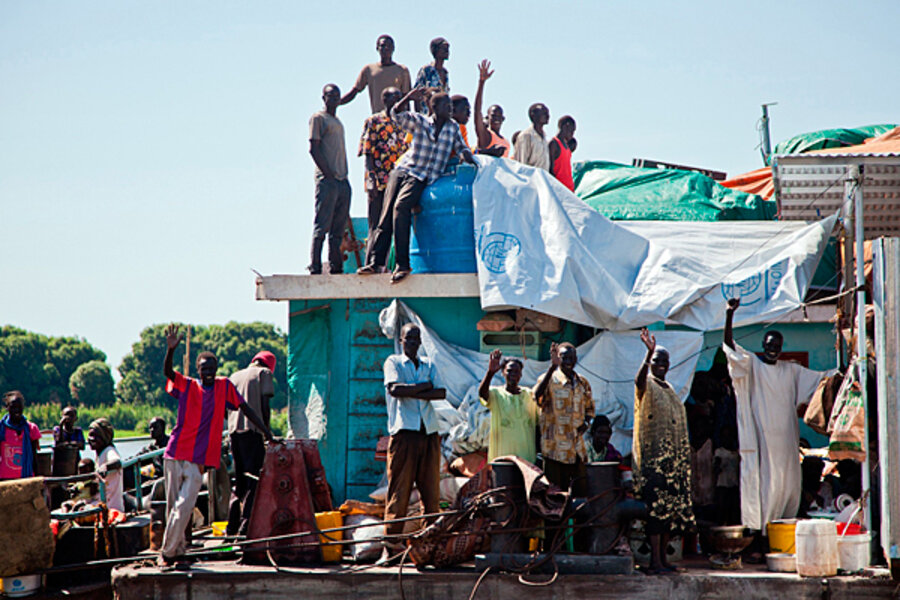Rains cool off war in South Sudan
Loading...
The onset of rains may accomplish what senior diplomats and elder statesmen have been unable to achieve: an end to fighting between Sudan and South Sudan.
When the six-month long rainy season comes to this part of the semi-arid Sahel region of Eastern Africa, hard meandering dirt roads become muddy and impassable. Troop trucks and tanks stay where they are, largely to prevent getting stuck up to the axles in mud. In a part of the world where asphalt roads exist only in the posh parts of larger towns, rainy season brings a natural halt to all traffic, warlike and otherwise.
Fighting doesn’t stop entirely, of course, and six months may not be enough time for these two sides to come up with compromises that they couldn’t come up with during the past seven years of relatively peaceful coexistence in the coalition government of a then-still-unified Sudan. But the respite is welcome.
As South Sudan Brig. Gen. Abraham Jongroon Deng told the Associated Press, “They relax and we relax. We wait until December. It will stop the war.”
The troubles go back nearly 30 years to the outbreak of civil war between north and south Sudan, when rebel leader John Garang launched a rebellion against Khartoum for what he regarded as neglect and discrimination of the Christian and non-Arab tribes of the south by the Arab-dominated north. A 2005 Comprehensive Peace Agreement gave some breathing space for the two warring sides to share power in a unified government, but old animosities lived on through internal squabbles, and in January 2011, South Sudanese citizens voted overwhelmingly to secede from the north. When the countries did separate, in July 2011, South Sudan ended up with nearly three-quarters of the unified Sudan’s oil reserves.
Former South African President Thabo Mbeki, the African Union's appointed mediator in the Sudan crisis, is due to arrive in Khartoum tomorrow to restart the peace process, but South Sudan's lead negotiator, Pagan Amum told Agence France Presse that Khartoum was stalling its return to the peace table.
Now the question is how to resolve those lingering issues.
- How to draw up final borders between the two countries, something that the peace agreement failed to do? South Sudan briefly occupied the Heglig oil fields north of the designated dividing line, and has since withdrawn, but South Sudanese claims on Heglig – as well as the town of Abyei – remain fixed in the minds of many politicians in Juba.
- How to divide up revenues from oil production? South Sudan is landlocked, and must pump its oil out through pipelines controlled by Khartoum, paying Khartoum substantial fees for this service. South Sudan – which cut off all oil production last month – argues that Khartoum is charging too much, but Khartoum argues its prices are reasonable, given that South Sudan has no other alternative. Khartoum, too, bears the distinct challenge of downsizing its government, a government that it must pay for now without those missing three-quarters of its previous oil revenues.
- How to deal with hundreds of thousands of southern Sudanese, still living in northern Sudan, whom Khartoum considers to be stateless. Aid groups like the International Organization for Migration and the United Nations High Commission for Refugees managed to persuade Khartoum to extend its deadline to help move southern refugees down to South Sudan, but South Sudan is barely able to meet the needs of its own population, let alone take on hundreds of thousands of newcomers.
- How to handle the armed separatist rebellions in Sudan’s borderline states of South Kordofan and Blue Nile? During the 20-year civil war, local populations supported Garang’s Sudan People’s Liberation Army, which now rules in South Sudan, but the peace agreement said that South Kordofan and Blue Nile states must resolve their future status through ill-defined “popular consultations.” Local SPLA members expected referendums, which would allow for secession. Khartoum rejected that idea. Armed rebellions now paralyze both states, with SPLA soldiers taking and holding territory, Sudanese war planes bombing villages, and civilians forced to take cover in caves of the Nuba Mountains.
- Finally, how to deal with the growing refugee crisis from the fighting in South Kordofan and Blue Nile states. UN agencies and international aid groups warn of a growing food crisis, as thousands of villagers who once were self-sufficient through farming have been unable to plant their crops because of the fighting. The stream of refugees coming into South Sudan now numbers into the tens of thousands, well beyond what the current refugee camps can handle.
"After more than ten months of fighting, with no sign of peace, we're on the path from crisis to catastrophe,” Oxfam's deputy country director for South Sudan, Johnson Byamukama, said in a joint statement with other aid groups.
For refugees, the rains will actually make matters worse, as tens of thousands of villagers strain the current sanitation systems in refugee camps.
“The coming rains could make life for refugees unbearable and bring the threat of waterborne disease. The world needs to wake up to the true cost of conflict for people who have already suffered so many years of war."
Get daily or weekly updates from CSMonitor.com delivered to your inbox. Sign up today.







